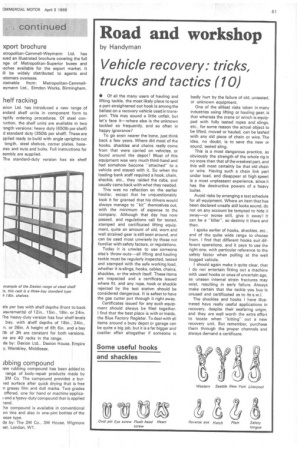Road and workshop
Page 63

If you've noticed an error in this article please click here to report it so we can fix it.
by Handyman
Vehicle recovery: tricks, trucks and tactics (10)
• Of all the many users of hauling and lifting tackle, the most likely place to spot a part-straightened out hook is among the ballast on a recovery vehicle used in transport. This may sound a little unfair, but let's face it—where else is the unknown tackled so frequently, and so often in happy ignorance?
To go even nearer the bone, just think back a few years. Where did most of the hooks, shackles and chains really come from that were carried on vehicles, or found around the depot? Most of this equipment was very much third-hand and had somehow become "attached" to a vehicle and stayed with it. So when the loading-bank staff required a hook, chain, shackle, etc., they raided the cabs, and usually came back with what they needed.
This was no reflection on the earlier haulier, except that he unquestionably took it for granted that his drivers would always manage to "kit" themselves out, with the minimum of expense to the company. Although that day has now passed, and regulations call for tested, stamped and certificated lifting equip ment, quite an amount of old, worn and well strained gear is still seen around, and can be used most unwisely by those not familiar with safety factors, or regulations.
Today it is unwise to use someone else's throw-outs all lifting and hauling tackle must be regularly inspected, tested and stamped with the safe working load, whether it is slings, hooks, cables, chains. shackles, or the winch itself. These items are inspected and a certificate issued where fit, and any rope, hook or shackle rejected by the test station should be considered dangerous. It is safest to have the gas cutter put through it right away.
Certificates issued for any such equipment should always be filed together. I find that the best place is with or inside, the Blue Factory Register. To deal with all items around a busy depot or garage can be quite a big job, but it is a far bigger and costlier affair altogether if someone is badly hurt by the failure of old, untested, or unknown equipment.
One of the silliest risks taken in many industries using lifting or hauling gear, is that whereas the crane or winch is equipped with fully tested ropes and slings, etc., for some reason the actual object to be lifted, moved or hauled, can be lashed with any old piece of chain or wire. The idea, no doubt, is to save the new or sound, tested sling.
This is a most dangerous practice. as obviously the strength of the whole rig is no more than that of the weakest part, and this will most certainly be that old chain or wire. Having such a chain link part under load, and disappear at high speed is a most unpleasant experience, since it has the destructive powers of a heavy bullet.
Avoid risks by arranging a test schedule for all equipment. Where an item that has been declared unsafe still looks sound, do not on any account be tempted to hide it away—or worse still, give it away! It can be a "killer", so destroy it there and then.
I spoke earlier of hooks, shackles, etc., and of the quite wide range to choose from. I find that different hooks suit different operations, and it pays to use the right-one, with particular reference to the safety factor when pulling at the well bogged vehicle.
I should again make it quite clear, that I do not entertain fitting out a machine with used hooks or ones of uncertain age, as unseen internal strain fractures may exist, resulting in early failure. Always make certain that the tackle you buy is unused and certificated as to its sm.!.
The shackles and hooks I have illustrated have really useful applications in recovery, despite their seafaring origin, and they are well worth the extra effort to locate when "kitting" out a new recovery unit. But remember, purchase them through the proper channels and always demand a certificate.




























































































































































